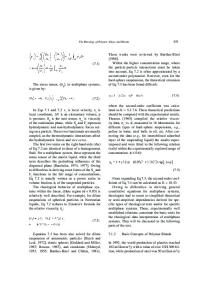Foaming of Miscible and Immiscible Polymer Blends
- PDF / 4,247,504 Bytes
- 7 Pages / 612 x 792 pts (letter) Page_size
- 63 Downloads / 366 Views
0977-FF14-04
Foaming of Miscible and Immiscible Polymer Blends Holger Ruckdaeschel1, Julius Rausch1, Jan K.W. Sandler1, Volker Altstaedt1, Holger Schmalz2, and Axel H.E. Mueller2 1 Polymer Engineering, University of Bayreuth, Universitaetsstrasse 30, Bayreuth, 95447, Germany 2 Macromolecular Chemistry II, University of Bayreuth, Universitaetsstrasse 30, Bayreuth, 95447, Germany
ABSTRACT Batch-foaming of miscible, immiscible and compatibilized polymer blend systems over a wide compositional range was carried out using carbon dioxide as a physical blowing agent. The resulting foam morphology was characterized by a detailed evaluation of foam density as well as of the cellular parameters. With regard to multiphase blends, transmission electron microscopic observations further provided a detailed insight into the cell wall morphology. The role of the melt-elongational properties and of the glass transition behavior of the various blend systems on the foaming characteristics was systematically elucidated. While the miscible blends showed a simple additivity behavior with regard to their foaming characteristics and properties, a significant influence of the initial blend morphology is demonstrated for the multiphase blends. INTRODUCTION There is an extensive body of literature regarding the foaming behavior of neat polymers as well as that of filled polymers using a variety of processing techniques [1,2]. However, comparatively little attention has been spent so far on the evaluation of the foamability of polymer blends. Yet, understanding and controlling the foaming process of blends could offer completely new possibilities with regard to the fine-tuning of both the processability and of the resulting properties as well as towards developing new foam morphologies [3], as demonstrated by first approaches [4-6]. The potential of polymer blends, while already established in numerous fields of compact applications [7], has not been fully exploited for the manufacture of low-density components. Therefore, the foaming behavior of polymer blends was systematically evaluated. Various binary mixtures of amorphous components were selected as reference materials, including miscible (poly(2,6-dimethyl-1,4-phenylene ether)/poly(styrene) (PPE/PS) and poly(styreneco-acrylonitrile)/poly(methyl methacrylate) (SAN/PMMA) blends as well as immiscible PPE/SAN. Furthermore, the influence of a compatibilization of such immiscible PPE/SAN blends with triblock copolymers was evaluated in detail. EXPERIMENT Polystyrene (PS, BASF, grade 145D, glass transition temperature 104 °C), polystyreneco-acrylonitrile (SAN, BASF, VLL19, 114 °C) and poly(2,6-dimethyl-1,4-phenylene ether)
(PPE, MEP, PX100F, 216 °C) were used as-received for melt-blending. Miscible PPE/PS and immiscible PPE/SAN blends were prepared by twin-screw extrusion (Brabender, DSE 20/40) and were subsequently pelletized. Moreover, a PPE/SAN 60/40 blend was melt-compatibilized by different contents of polystyrene-b-polybutadiene-b-poly(methyl methacrylate) triblock terpolymers (SBM, 3
Data Loading...











